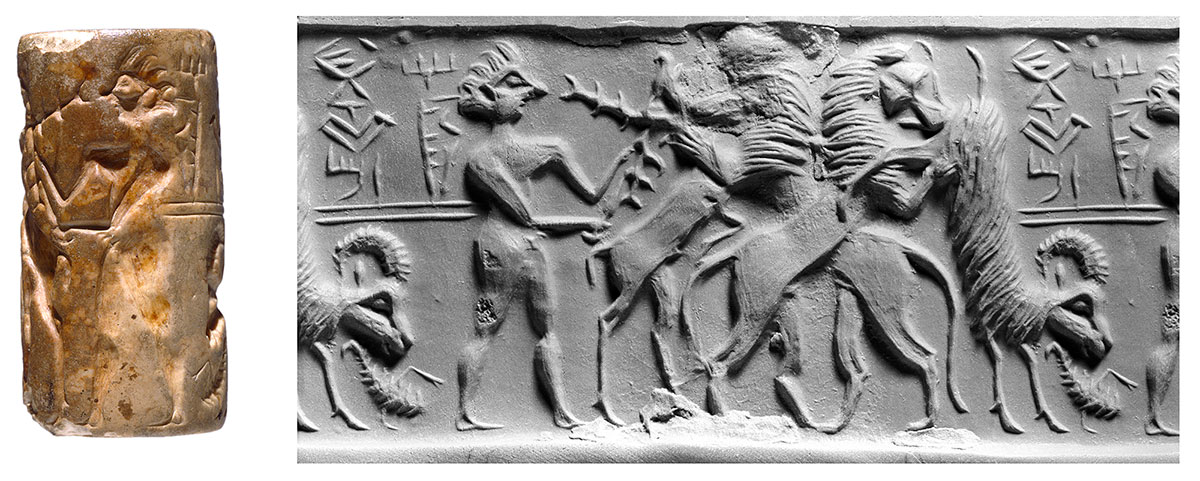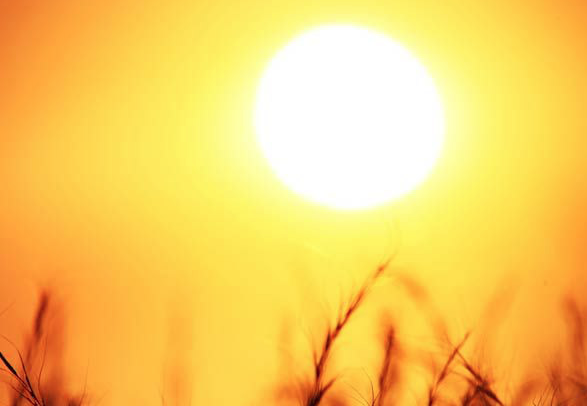
Thread: Middle Assyrian Cylinder Seal with a "Lion-Dragon", 1300-1200 BC.
I found this seal on this great site archaicwonder.tumblr.com/post/145026318… Unfortunately I am unable to get more info (where the seal was found, where it is now) cause the link provided is dead. But the seal is AMAZING
I found this seal on this great site archaicwonder.tumblr.com/post/145026318… Unfortunately I am unable to get more info (where the seal was found, where it is now) cause the link provided is dead. But the seal is AMAZING

The seal depicts a tiny flying dude facing an advancing giant winged monster with lion body, bull horns and scorpion tail...Above the monster are some "heavenly objects", namely 7 stars, most likely Pleiades, a large star, most likely Sirius, and a crescent moon...
Why is this seal so special?
Cause this seal is an amazing example of a complex animal calendar marker.
It is also an amazing example of the mapping of these ancient animal calendar markers to "heavenly objects".
Cause this seal is an amazing example of a complex animal calendar marker.
It is also an amazing example of the mapping of these ancient animal calendar markers to "heavenly objects".
It is also a proof that the symbolism we find in Achaemenid Iran is already present in Assyria almost a millennium earlier...I am talking about the "flying dude" and the so called "dragon-lion"...
Finally, this seal allows us to determine the actual meaning of these "religious" symbols...The old, original meanings, before their meaning was obscured by the various religious interpretations...
So I will start by reminding you of this recent thread, in which I explained why I thought that the flying dude is Ninurta, the old rain (and war) god, who was originally imagined as a huge black bird (eagle) with outstretched wings. The rain bird....
https://twitter.com/serbiaireland/status/1435241707591933953
At the end of the above thread I said that I also believe that this symbol was later appropriated to represent Ahura Mazda...And in this thread I would like to first explain why I think so.
I will start with this thread, in which I talked about the obsession of Achaemenid kings with killing lions, and why I thought that this was a ritual act.
https://twitter.com/serbiaireland/status/1379469997223862273
The discription of this scene is very important: "The King killing Angra Mainyu", the main adversary of Ahura Mazda, the highest deity of Zoroastrianism...Angra Mainyu is depicted as a "mythical beast", a winged lion with eagle talons and bull horns...
Now in the rest of the above thread I went on to explain that this "mythical beast", is the symbolic depiction of the hot dry half of the year, which starts in Apr/May (Taurus), is the hottest and driest in Jul/Aug (Leo) and ends in Oct/Nov (Eagle)... 

Wait the second. Eagle? Oh yeah...Did you know that Scorpio is the only zodiac sign which has a double. Eagle...I talked about this in my post about four living creatures oldeuropeanculture.blogspot.com/2019/04/four-l… 

So if we replace eagle with scorpion, we get...The mythical beast from the Assyrian cylinder seal we are talking about in this thread. We still have a winged lion with bull horns. But this time instead of eagle talons it has lion paws...The monster however has a scorpion tail...
And again this represents the hot dry half of the year, which starts in Apr/May (Taurus), is the hottest and driest in Jul/Aug (Leo) and ends in Oct/Nov (Scorpio)... 

But these are not zodiac constellations...
The zodiac with Taurus, Leo, Scorpio...was not invented before 300BC at the earliest, and most likely originated in Europe, where the oldest astrologer circular board was found
oldeuropeanculture.blogspot.com/2020/07/nakova…
The zodiac with Taurus, Leo, Scorpio...was not invented before 300BC at the earliest, and most likely originated in Europe, where the oldest astrologer circular board was found
oldeuropeanculture.blogspot.com/2020/07/nakova…
The bull, lion, eagle, scorpion we are talking about are animal calendar markers. Ancient symbols which predate constellations by millenniums...And which were derived from the easily observable behavior of the animals in question, which happened every year at the same time...
Usually these symbols mark either mating or birthing of the animal in question. For instance Taurus marks the beginning of the calving season of the wild Eurasian cattle (May). I talked about it in this thread
https://twitter.com/serbiaireland/status/1418943941286797318
Leo marks the beginning of the main mating season of the Eurasian lions (Aug). I talked about it in this thread
https://twitter.com/serbiaireland/status/1391826979343802371
Eagle (Vulture) marks the beginning of the mating season of the Vultures (Nov). I talked about it in this thread
https://twitter.com/serbiaireland/status/1429492612461903881
But in case of scorpion, this animal calendar marker marks the time when scorpions disappear from nature and appear in people's homes because the weather outside gets too cold and wet...
I first talked about it in my post about this Dilmun seal oldeuropeanculture.blogspot.com/2020/05/dilmun…
I first talked about it in my post about this Dilmun seal oldeuropeanculture.blogspot.com/2020/05/dilmun…

I then talked about it in my post about this cylinder seal which belonged to the Queen Puabi oldeuropeanculture.blogspot.com/2020/06/queen-… 

I also talked about it in my post about the Scorpion man archer oldeuropeanculture.blogspot.com/2020/06/bird-m… 

When we look at the complex combination of the animal calendar markers present on these seals, they all place scorpion at the end on hot dry season and the beginning of the cool wet season (Oct/Nov)...
Knowing this, this Assyrian "mythical animal" is a much better animal calendar marker for the hot and dry season than Achaemenid one. The head (bull) body (lion) and tail (scorpion) correspond exactly to the beginning (May) middle (Aug) and end (Nov) of the hot, dry season... 

But this is basically the same complex animal calendar marker...With the same meaning...Hot dry season...Otherwise known as Nergal, the god of death, who was depicted as a lion...Remember, Leo marks the beginning of droughts... oldeuropeanculture.blogspot.com/2021/05/winged… 

Or a "dragon with lion body and seven snake heads"...Cause the old Mesopotamian summer lasted seven lunar months...Apr/May, May/Jun, Jun/Jul, Jul/Aug, Aug/Sep, Sep/Oct, Oct/Nov...So Lion-Dragon 🙂 oldeuropeanculture.blogspot.com/2020/07/seven-… 

Snake heads because snakes are the symbol of sun's heat...The only true solar animals, which are in our world when sun is in our world and in the underworld when sun is in the underworld...I talked a lot about snakes in this thread
https://twitter.com/serbiaireland/status/1410720047450951691
There is another symbol that represents the hot dry season. Angra Mainiu...In the earliest Zoroastian texts, Angra ("destructive", "chaotic", "disorderly", "inhibitive", "malign") Mainyu ("Energy", "Force", "Sprit", "Mind")...
Angra Mainiu was the antithesis of Spenta ("Holy", "Creative", "Bounteous") Mainyu ("Energy", "Force", "Sprit", "Mind")...
Now think about what brings order and disorder to an agricultural society? Which is why I believe that originally Angra Mainyu and Spenta Mainyu were, just two opposing natural forces: sun (Nergal) and rain (Ninurta)...Which later became Ahriman (devil) and Ahura Mazda (god)... 



And so if the monster is the symbol of Angra Mainiu, the hot dry season, this means that the flying dude is the symbol of Spenta Mainiu, rain...Or more precisely, of the guy who brings rain and stops the monster of drought...Ninurta, the rain god...Or Ahura Mazda...
Soooo...That's that...
Nope...
Here is the best bit. Do you see the three "heavenly objects" above the monster of the hot dry season? They are not there as a random decoration. The choice and the position of these "heavenly objects" is very deliberate. Look at this:
Nope...
Here is the best bit. Do you see the three "heavenly objects" above the monster of the hot dry season? They are not there as a random decoration. The choice and the position of these "heavenly objects" is very deliberate. Look at this:
Pleiades above the bull horns. Pleiades used to rise with the sun during Taurus (Apr/May).
Sirius above the lion body. Sirius used to rise with the sun during Leo (Jul/Aug).
Winter Moon over scorpion tail. Winter moon points upwards in the northern hemisphere (Oct/Nov).
Sirius above the lion body. Sirius used to rise with the sun during Leo (Jul/Aug).
Winter Moon over scorpion tail. Winter moon points upwards in the northern hemisphere (Oct/Nov).

So these three "heavenly objects" basically mark the beginning, the middle and the end of the same half of the year marked by the beginning, the middle and the end of the mythical beast that they are placed above...
I think this is really cool, right?
But believe or not there is another explanation for these three "heavenly objects" which also fits perfectly with the total meaning of the rest of this image: the end of hot dry half of the year.
Remember, Ninurta stops the monster of drought
But believe or not there is another explanation for these three "heavenly objects" which also fits perfectly with the total meaning of the rest of this image: the end of hot dry half of the year.
Remember, Ninurta stops the monster of drought
As I said, the crescent moon pointing upwards is the symbol of winter. But also the symbol of night...And winter is the time when both Pleiades and Sirius become visible in the night sky with the moon...
So taken like this, the three symbols mean "winter", more specifically beginning of the "cool wet half of the year" which brings the end to the "hot dry half of the year"...
When the storm bird kills the drought dragon lion...When Ninurta kills Nergal...When Spenta Mainyu overpowers Angra Mainiu...When Ahura Mazda overpowers Ahriman...
I talked about this meaning of these three symbols in my post about this seal...In it I proposed that the meaning means: "plow your field and sow your grain when the moon, pleiades and Sirius are visible in the night sky"
oldeuropeanculture.blogspot.com/2020/06/7-star…
oldeuropeanculture.blogspot.com/2020/06/7-star…

So...This is it...As I said, the seal is amazing...Sorry for this thread being so long. But there was so much stuff encoded in that one image...I hope the discussion was interesting...
Keep smiling 🙂
Keep smiling 🙂
PS: More about animal calendar markers found in ancient cultures, start here oldeuropeanculture.blogspot.com/p/animal-solar… then check the rest of the blog posts I still didn't add to this page, and finally check my twitter threads I still didn't convert to blog post...I am 6 months behind now
• • •
Missing some Tweet in this thread? You can try to
force a refresh














